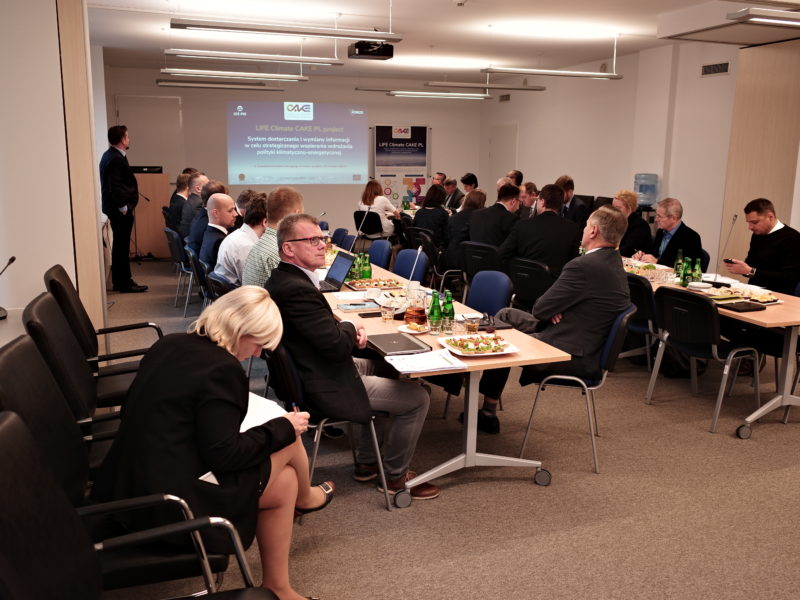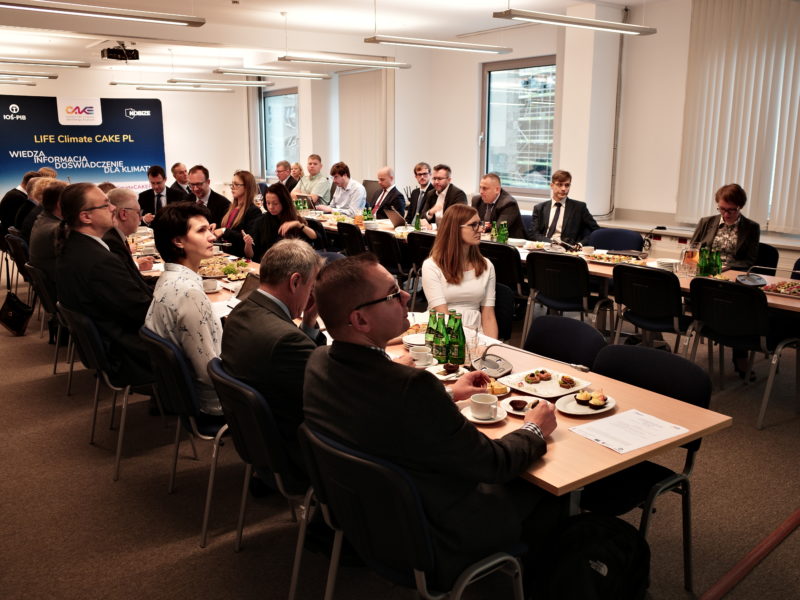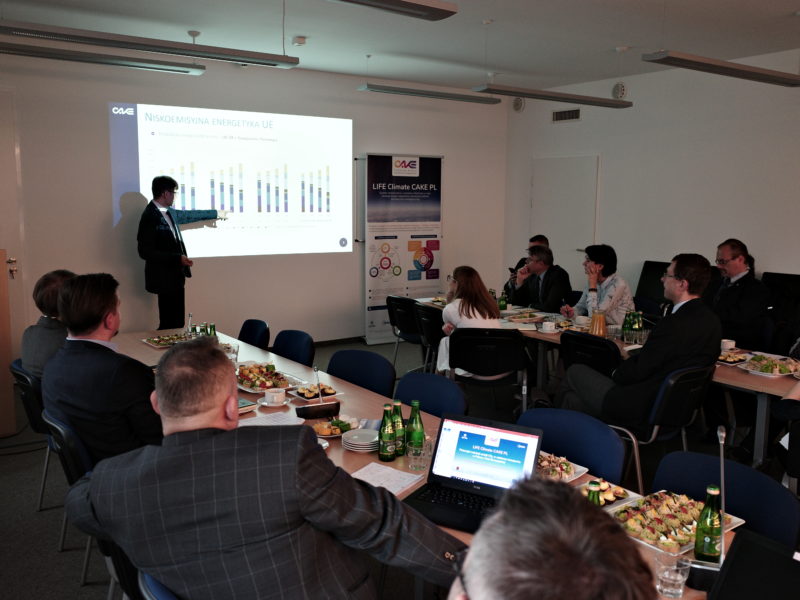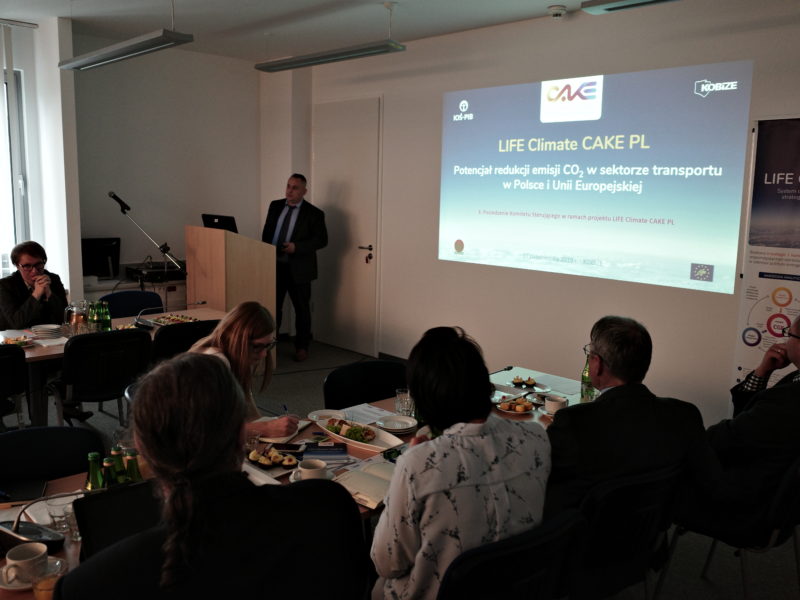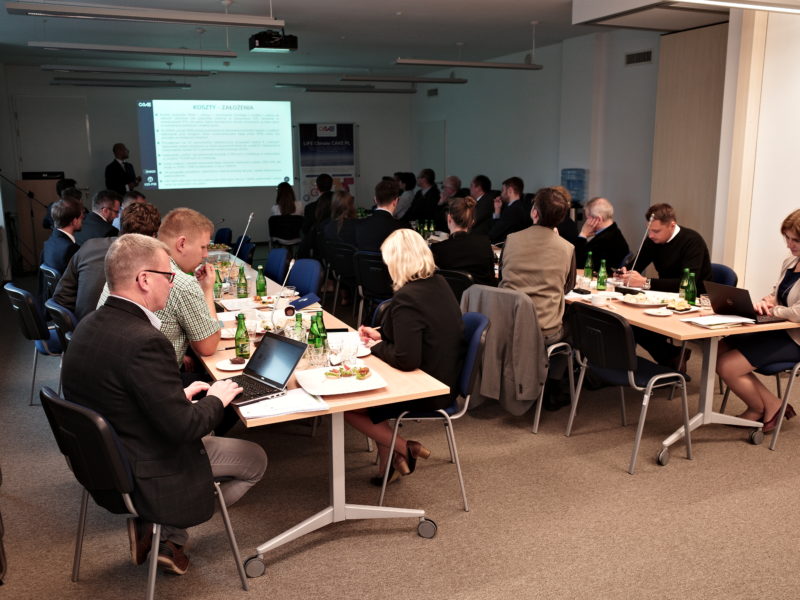Third LIFE Climate CAKE PL Steering Committee meeting
On the 17 of October 2019 r. third Steering Committee and Working Group meeting of LIFE Climate CAKE PL project was held at KOBiZE’s office.
Representatives of public governmental administration dealing with the climate and energy policy issues participated in the meeting (Ministry of: Evironment, Energy, Finance, Foreign Affairs, Infrastructure, Entrepreneurship and Technology, Investment and Development).
In the introduction part the key information on the progress made according to project implementation and future planned actions were presented.
Then the results of the energy mix analysis for EU Member States and the costs in various reduction scenarios in the Energy sector were presented (targets up to 2050):
- BASE–reduction achieved: 60%*;
- BAU– 2050 reduction target 80%*;
- DEEP– 2050 reduction target 95%*;
- NN DEEP – 2050 reduction target 95%*,but without the possibility of building new nuclear sources;
* Emission reduction levels compared to 2015.
The analysis was perfomred using the MEESA sector model (Model for European Energy System Analysis) developed as part of the LIFE Climate CAKE PL project. The purpose of the model is to comprehensively analyze the impact of various policies on the energy sector (i.e. electricity and district heating). The model covers EU-28 countries as well as Norway and Switzerland, takes into account cross-border exchanges, and the results are obtained in the horizon to 2050. The model analyzes approx. 50 energy generation technologies. Demand curves for each country are based on historical ENTSO-E data.
Celem modelu jest kompleksowa analiza wpływu różnego rodzaju polityk na sytuację sektora energetycznego (tj. wytwarzania energii elektrycznej i ciepła sieciowego). Model obejmuje państwa UE-28 oraz Norwegię i Szwajcarię, uwzględnia wymianę transgraniczną, a wyniki są uzyskiwane w horyzoncie do 2050 r. Model analizuje ok. 50 technologii wytwarzania energii. Krzywe zapotrzebowania dla każdego kraju są oparte o historyczne dane ENTSO-E.
Some preliminary conclusions form analysis are presented below:
- In the DEEP and h DEEP i DEEP NN the use of gas in electricity generation is smaller than in the moderate reduction scenario due to the significant increase in CO2 emission costs, while gas units remain significant from the point of view of power reserve.
- In the DEEP scenario, there is a significant development of nuclear power plants, while in the DEEP NN scenario the role of gas power plants with CCS and the role of RES sources is growing.
- In the REF and BAU scenarios, hard coal is used longer – mainly in combined heat and power plants.
- In all scenarios RES are developing dynamically.
- DEEP and DEEP NN scenarios mean that there would be a clear increase in future manufacturing costs relative to the REF scenario.
- The national politics of different European Union countries regarding resigantion form carbon and development of RES would cause significant emission reduction by 2030.
- There is an mutual interaction of national policies – eg. without enforced renewable energy targets, marginal costs of emission start to rise earlier (while target cost levels are similar).
- In 2050, there is a large increase in the cost of marginal reductions. After 2050, these costs stabilize and even gradually decrease.
Then, the results of the analysis based on the transport model – TR3E (Transport European Economic Model) were presented. The dynamic partial equilibrium model of the TR3E transport sector is oriented towards a long time horizon (up to 2050 in annual intervals) and covers all transport subsectors (road, rail, air and water) in 28 EU Member States. The model takes into account the development of new vehicles and technologies (through low-emission vehicles – hybrids and electric) and uses technologies based on existing fuels (diesel, gasoline, CNG, LPG). The data sets on which the model is based are the JRC IDEES database – with data on activity, mileage, occupancy or loading, and TRACCS – with data on the costs and prices of new vehicles.
Three scenarios were assumed for analysis:
- Baseline scenario – vehicle prices maintained at the same level until 2050, development of activity and emissions based on the PRIMES 2016 reference scenario,
- Technical development scenario (Low, Moderate, High) – prices of electric and hybrid cars, aviation costs and emissions are falling compared to the baseline scenario, the costs in the aviation sector are increasing (in order to limit the increase of emissions from increased activities in the aviation sector),
- „Forced” electromobility – the gradually increasing share of electric cars in the sale of new cars until 2040, since only electric and hybrid cars are sold (so changes in the share of new cars are not the result of changes in prices, but of the legal regulation), aviation costs are rising just as in the technical development scenario.
Some of the preliminary results are presented below.
The significant emission reduction target in the transport sector is difficult, but possible and at the same time it requires:
- Dynamic increase in sales of electric vehicles (including HDV electric trucks);
- Reduction of the level of usage of air transport or a significant decrease in emmisivity;
- These goals can be achieved spontaneously, in the case of a significant drop in prices of electric vehicles and rapid development of infrastructure, they can also be enforced by law (scenario of forced electromobility);
- In scenarios taking into account the rapid decrease in prices of electric vehicles, the costs are incurred initially by users (purchase of vehicles), which are later offset by fuel savings. In the forced electromobility scenario, these expenses are higher and savings come at the later stage.
Long-term analyzes of the energy generation and transport sector carried out as part of the CAKE project are of great importance from the point of view of upcoming decisions on setting reduction targets at the EU level by 2050. The analyzes performed by the CAKE team show i.e. the use of various reduction mechanisms and their impact on the shaping of the energy mix and car structure in the individual Member States, as well as the costs for the economy. The results obtained show how important changes in the energy sector or other EU sectors will have to take place in order to achieve climate neutrality.
Back

 Reset ustawień
Reset ustawień Kontrast
Kontrast Widok
Widok Czytelność
Czytelność Czcionka
Czcionka Znaki
Znaki Interlinia
Interlinia Słowa
Słowa Akapity
Akapity Deklaracja dostępności
Deklaracja dostępności




